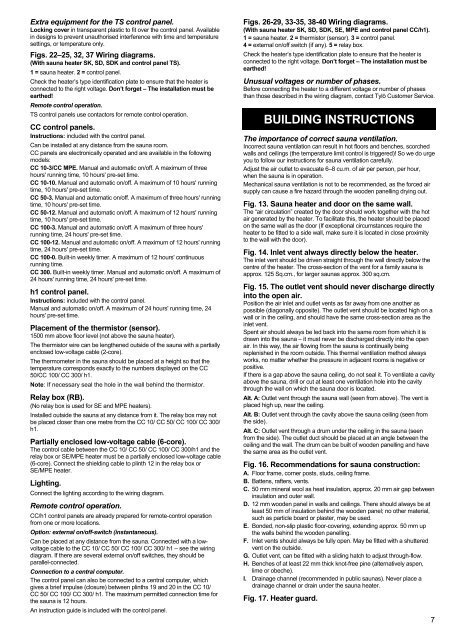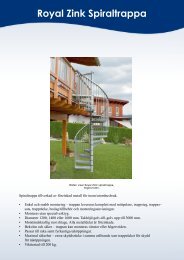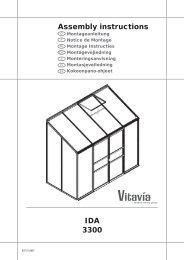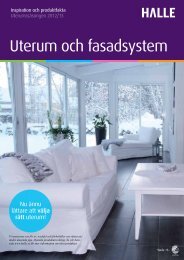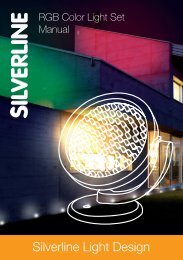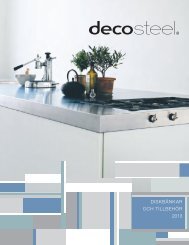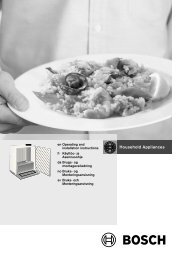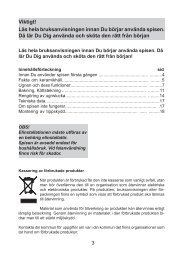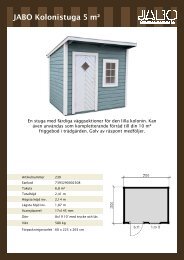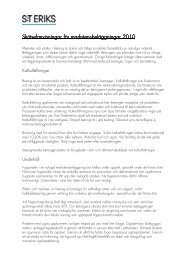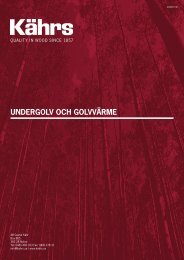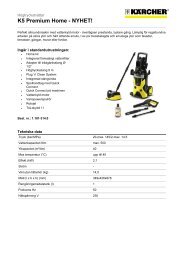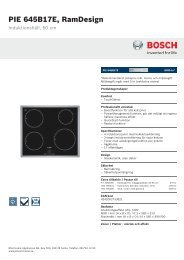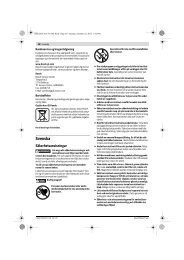CC MPE - Tylö
CC MPE - Tylö
CC MPE - Tylö
Create successful ePaper yourself
Turn your PDF publications into a flip-book with our unique Google optimized e-Paper software.
Extra equipment for the TS control panel.Locking cover in transparent plastic to fit over the control panel. Availablein designs to prevent unauthorised interference with time and temperaturesettings, or temperature only.Figs. 22–25, 32, 37 Wiring diagrams.(With sauna heater SK, SD, SDK and control panel TS).1 = sauna heater. 2 = control panel.Check the heater’s type identification plate to ensure that the heater isconnected to the right voltage. Don’t forget – The installation must beearthed!Remote control operation.TS control panels use contactors for remote control operation.<strong>CC</strong> control panels.Instructions: included with the control panel.Can be installed at any distance from the sauna room.<strong>CC</strong> panels are electronically operated and are available in the followingmodels:<strong>CC</strong> 10-3/<strong>CC</strong> <strong>MPE</strong>. Manual and automatic on/off. A maximum of threehours' running time, 10 hours' pre-set time.<strong>CC</strong> 10-10. Manual and automatic on/off. A maximum of 10 hours' runningtime, 10 hours' pre-set time.<strong>CC</strong> 50-3. Manual and automatic on/off. A maximum of three hours' runningtime, 10 hours' pre-set time.<strong>CC</strong> 50-12. Manual and automatic on/off. A maximum of 12 hours' runningtime, 10 hours' pre-set time.<strong>CC</strong> 100-3. Manual and automatic on/off. A maximum of three hours'running time, 24 hours' pre-set time.<strong>CC</strong> 100-12. Manual and automatic on/off. A maximum of 12 hours' runningtime, 24 hours' pre-set time.<strong>CC</strong> 100-0. Built-in weekly timer. A maximum of 12 hours' continuousrunning time.<strong>CC</strong> 300. Built-in weekly timer. Manual and automatic on/off. A maximum of24 hours' running time, 24 hours' pre-set time.h1 control panel.Instructions: included with the control panel.Manual and automatic on/off. A maximum of 24 hours' running time, 24hours' pre-set time.Placement of the thermistor (sensor).1500 mm above floor level (not above the sauna heater).The thermistor wire can be lengthened outside of the sauna with a partiallyenclosed low-voltage cable (2-core).The thermometer in the sauna should be placed at a height so that thetemperature corresponds exactly to the numbers displayed on the <strong>CC</strong>50/<strong>CC</strong> 100/ <strong>CC</strong> 300/ h1.Note: If necessary seal the hole in the wall behind the thermistor.Relay box (RB).(No relay box is used for SE and <strong>MPE</strong> heaters).Installed outside the sauna at any distance from it. The relay box may notbe placed closer than one metre from the <strong>CC</strong> 10/ <strong>CC</strong> 50/ <strong>CC</strong> 100/ <strong>CC</strong> 300/h1.Partially enclosed low-voltage cable (6-core).The control cable between the <strong>CC</strong> 10/ <strong>CC</strong> 50/ <strong>CC</strong> 100/ <strong>CC</strong> 300/h1 and therelay box or SE/<strong>MPE</strong> heater must be a partially enclosed low-voltage cable(6-core). Connect the shielding cable to plinth 12 in the relay box orSE/<strong>MPE</strong> heater.Lighting.Connect the lighting according to the wiring diagram.Remote control operation.<strong>CC</strong>/h1 control panels are already prepared for remote-control operationfrom one or more locations.Option: external on/off-switch (instantaneous).Can be placed at any distance from the sauna. Connected with a lowvoltagecable to the <strong>CC</strong> 10/ <strong>CC</strong> 50/ <strong>CC</strong> 100/ <strong>CC</strong> 300/ h1 – see the wiringdiagram. If there are several external on/off switches, they should beparallel-connected.Connection to a central computer.The control panel can also be connected to a central computer, whichgives a brief impulse (closure) between plinths 19 and 20 in the <strong>CC</strong> 10/<strong>CC</strong> 50/ <strong>CC</strong> 100/ <strong>CC</strong> 300/ h1. The maximum permitted connection time forthe sauna is 12 hours.An instruction guide is included with the control panel.Figs. 26-29, 33-35, 38-40 Wiring diagrams.(With sauna heater SK, SD, SDK, SE, <strong>MPE</strong> and control panel <strong>CC</strong>/h1).1 = sauna heater. 2 = thermistor (sensor). 3 = control panel.4 = external on/off switch (if any). 5 = relay box.Check the heater’s type identification plate to ensure that the heater isconnected to the right voltage. Don’t forget – The installation must beearthed!Unusual voltages or number of phases.Before connecting the heater to a different voltage or number of phasesthan those described in the wiring diagram, contact Tylö Customer Service.BUILDING INSTRUCTIONSThe importance of correct sauna ventilation.Incorrect sauna ventilation can result in hot floors and benches, scorchedwalls and ceilings (the temperature limit control is triggered)! So we do urgeyou to follow our instructions for sauna ventilation carefully.Adjust the air outlet to evacuate 6–8 cu.m. of air per person, per hour,when the sauna is in operation.Mechanical sauna ventilation is not to be recommended, as the forced airsupply can cause a fire hazard through the wooden panelling drying out.Fig. 13. Sauna heater and door on the same wall.The “air circulation” created by the door should work together with the hotair generated by the heater. To facilitate this, the heater should be placedon the same wall as the door (If exceptional circumstances require theheater to be fitted to a side wall, make sure it is located in close proximityto the wall with the door).Fig. 14. Inlet vent always directly below the heater.The inlet vent should be driven straight through the wall directly below thecentre of the heater. The cross-section of the vent for a family sauna isapprox. 125 Sq.cm., for larger saunas approx. 300 sq.cm.Fig. 15. The outlet vent should never discharge directlyinto the open air.Position the air inlet and outlet vents as far away from one another aspossible (diagonally opposite). The outlet vent should be located high on awall or in the ceiling, and should have the same cross-section area as theinlet vent.Spent air should always be led back into the same room from which it isdrawn into the sauna – it must never be discharged directly into the openair. In this way, the air flowing from the sauna is continually beingreplenished in the room outside. This thermal ventilation method alwaysworks, no matter whether the pressure in adjacent rooms is negative orpositive.If there is a gap above the sauna ceiling, do not seal it. To ventilate a cavityabove the sauna, drill or cut at least one ventilation hole into the cavitythrough the wall on which the sauna door is located.Alt. A: Outlet vent through the sauna wall (seen from above). The vent isplaced high up, near the ceiling.Alt. B: Outlet vent through the cavity above the sauna ceiling (seen fromthe side).Alt. C: Outlet vent through a drum under the ceiling in the sauna (seenfrom the side). The outlet duct should be placed at an angle between theceiling and the wall. The drum can be built of wooden panelling and havethe same area as the outlet vent.Fig. 16. Recommendations for sauna construction:A. Floor frame, corner posts, studs, ceiling frame.B. Battens, rafters, vents.C. 50 mm mineral wool as heat insulation, approx. 20 mm air gap betweeninsulation and outer wall.D. 12 mm wooden panel in walls and ceilings. There should always be atleast 50 mm of insulation behind the wooden panel; no other material,such as particle board or plaster, may be used.E. Bonded, non-slip plastic floor-covering, extending approx. 50 mm upthe walls behind the wooden panelling.F. Inlet vents should always be fully open. May be fitted with a shutteredvent on the outside.G. Outlet vent, can be fitted with a sliding hatch to adjust through-flow.H. Benches of at least 22 mm thick knot-free pine (alternatively aspen,lime or obeche).I. Drainage channel (recommended in public saunas). Never place adrainage channel or drain under the sauna heater.Fig. 17. Heater guard.7


